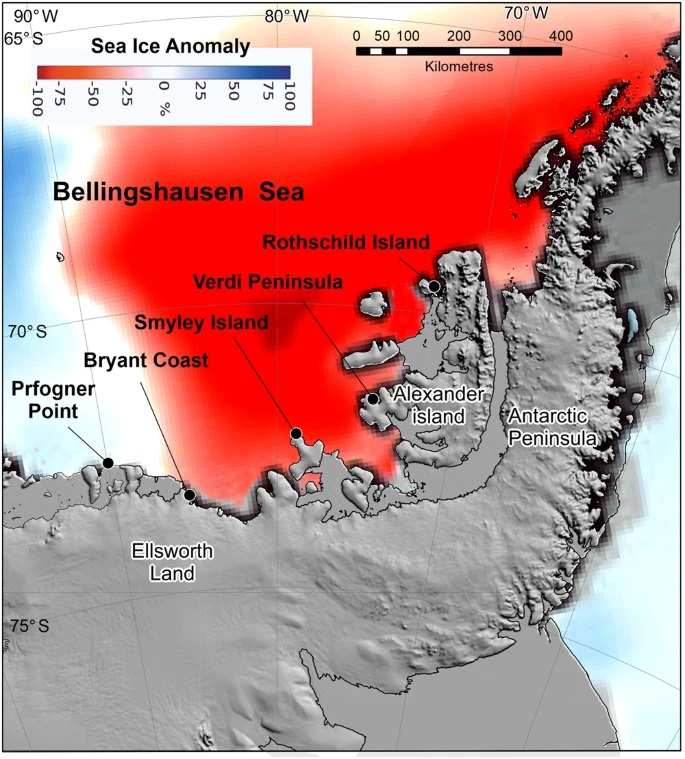The loss of sea ice in Antarctica in 2022 caused the complete failure of four out of five known emperor penguin breeding colonies. The worst hit areas were in the central and eastern Bellingshausen Sea region, where some parts witnessed a 100 percent loss of sea ice concentration.
In a devastating new study produced by researchers with the British Antarctic Survey (BAS), satellite images show that none of the chicks survived in these colonies, in what is the first recorded widespread breeding failure in these animals. Unfortunately, the team of researchers believes this is just a sign of things to come. If the effects of climate change are not mitigated, over 90 percent of emperor penguin colonies will be “quasi-extinct” by the end of the century, based on current trends.
Emperor penguins rely on stable sea ice – known as “fast ice”, which is securely connected to the shore for most of the year – from April to January. These large penguins tend to lay their eggs between May and June, which is in the Antarctic winter. The eggs then hatch around 65 days later, but the chicks don’t fledge (develop their wing feathers or, in the case of penguins, waterproof feathers, so they can leave the nest to hunt) until December or January.
The breeding season for 2022 was like most others, to begin with, but then the fast ice broke up early and retreated to a similar extent as the all-time low recorded in summer 2021.
There are five colonies of breeding penguins in the region around the Bellingshausen Sea, to the west of the Antarctic peninsula. The size of these colonies varies from between 630 to 3,500 breeding pairs. However, when the incident occurred in 2022, only the colony at Rothschild Island was able to fledge. Despite their best efforts, the researchers have not been able to find any signs of the chicks from the other four locations. It is likely the baby birds either froze to death or drowned before they were able to develop their waterproof feathers.
“We have never seen emperor penguins fail to breed, at this scale, in a single season. The loss of sea ice in this region during the Antarctic summer made it very unlikely that displaced chicks would survive”, lead author of the study, Dr Peter Fretwell said in a statement.
“We know that emperor penguins are highly vulnerable in a warming climate – and current scientific evidence suggests that extreme sea ice loss events like this will become more frequent and widespread.”
The Antarctic has now seen four years since 2016 when the ice has been at its lowest since satellite records started 45 years ago. The two lowest years were in 2021/22 and 2022/23.
In the past, emperor penguins disturbed by sea ice loss adapted by moving to more stable areas in the following year. However, this approach is not sustainable if the sea ice habitat disappears across an entire region.
According to Dr Caroline Holmes, a polar climate scientist with BAS, “Right now, in August 2023, the sea ice extent in Antarctica is still far below all previous records for this time of year. In this period where oceans are freezing up, we’re seeing areas that are still, remarkably, largely ice-free.”
“Year-to-year changes in sea ice extent are linked to natural atmospheric patterns such as El Niño-Southern Oscillation, the strength of the southern hemisphere jet stream, and regional low-pressure systems.”
“We’ll need years of targeted observations and modelling to know precisely how much the current conditions are being influenced by these phenomena and by natural ocean variability. However, the recent years of tumbling sea ice records and warming of the subsurface Southern Ocean point strongly to human-induced global warming exacerbating these extremes.”
This new paper dramatically shows the association between sea ice loss and ecosystem destruction, especially in relation to changing climate conditions.
“Climate change is melting sea ice at an alarming rate. It is likely to be absent from the Arctic in the 2030s – and in the Antarctic, the four lowest sea ice extents recorded have been since 2016”, Dr Jeremy Wilkinson, a sea ice physicists at BAC explained.
“It is another warning sign for humanity that we cannot continue down this path, politicians must act to minimize the impact of climate change. There is no time left.”
The study was published in the journal Communications Earth & Environment.
Source Link: Up to 10,000 Emperor Penguin Chicks Killed By Melting Antarctic Ice
